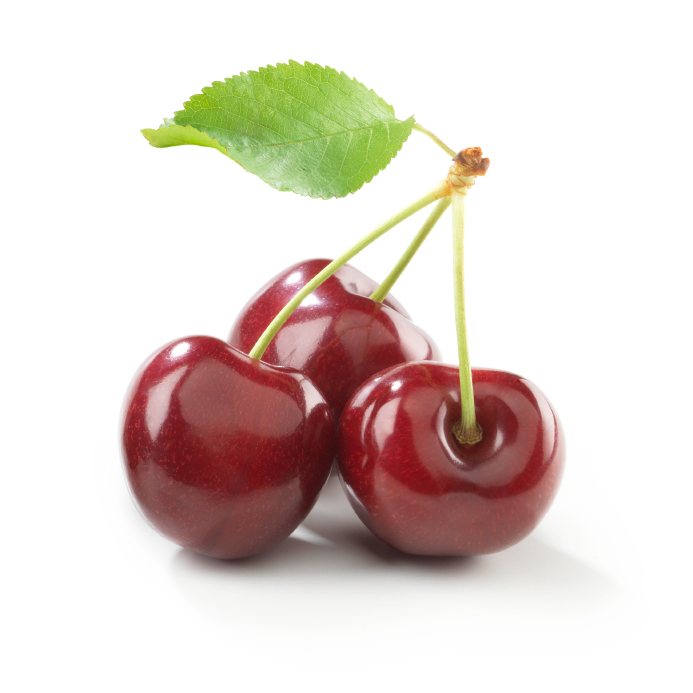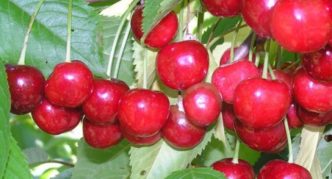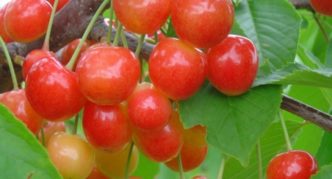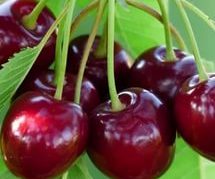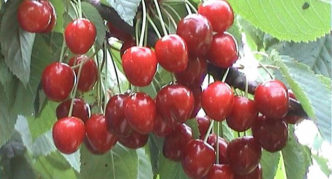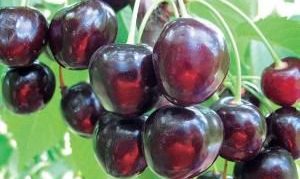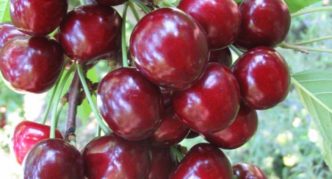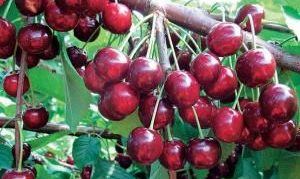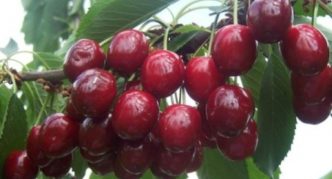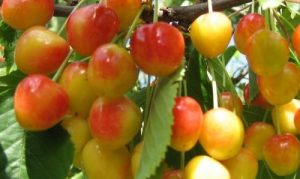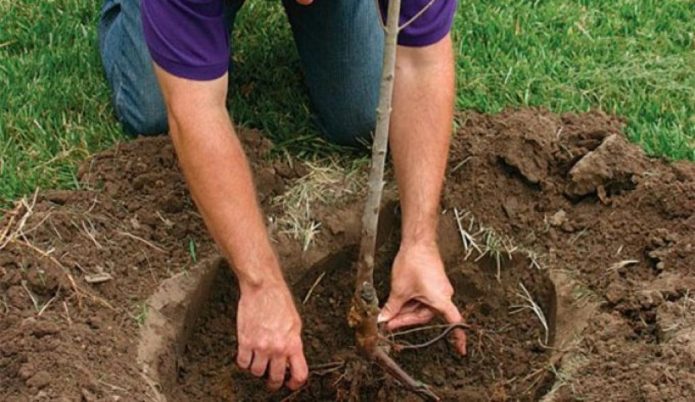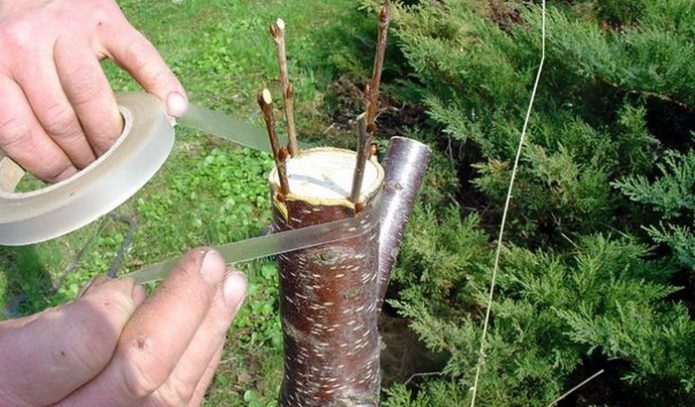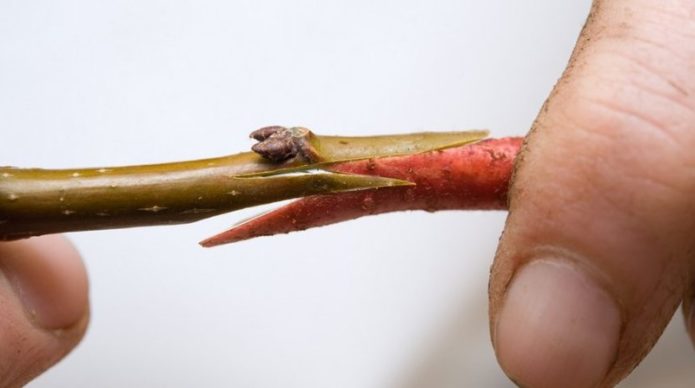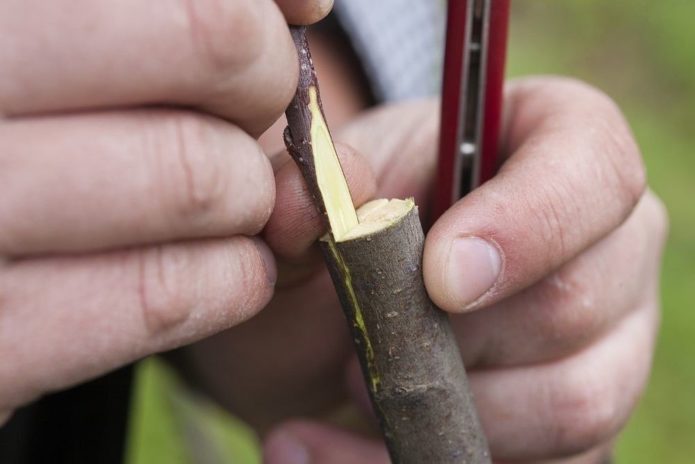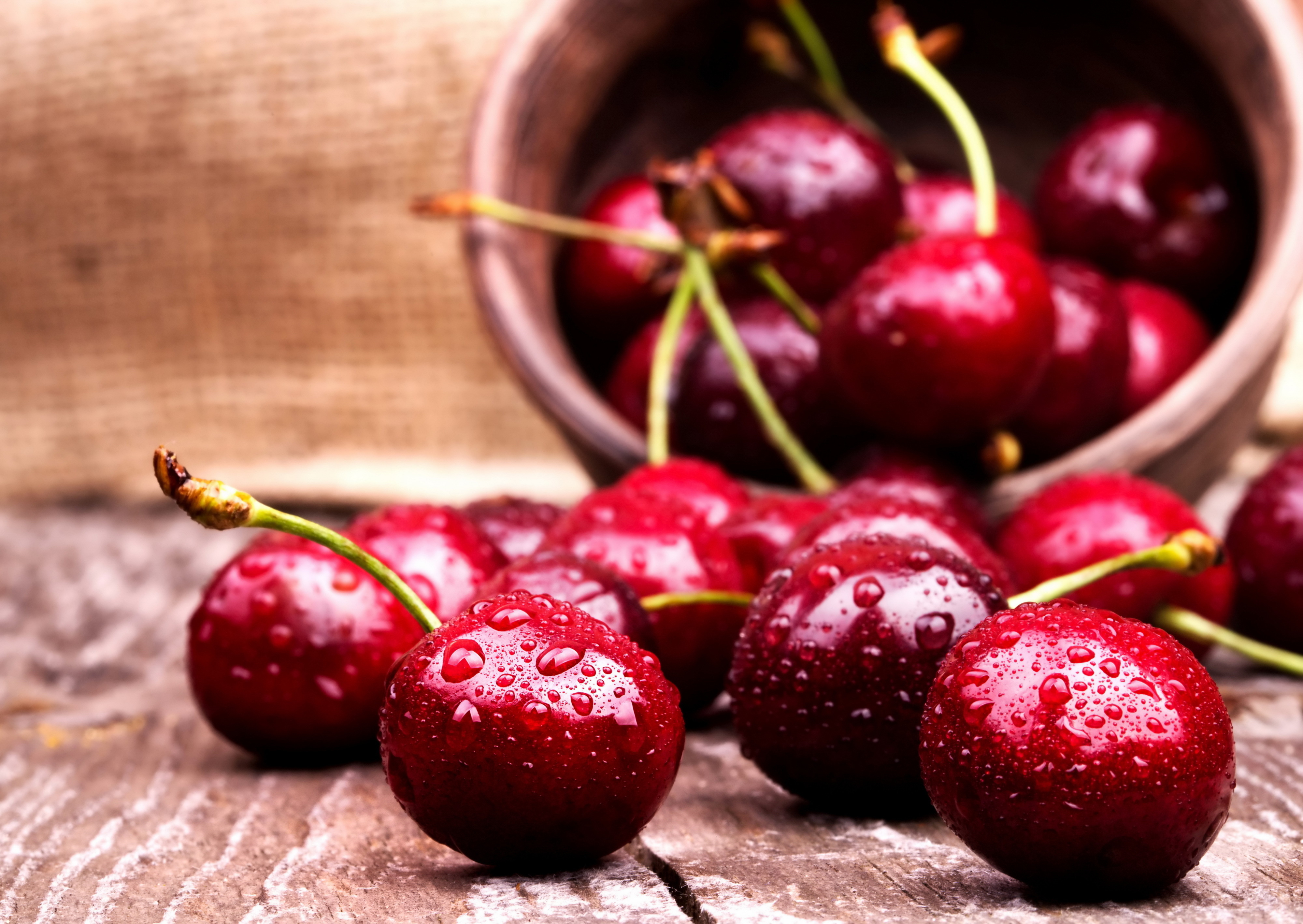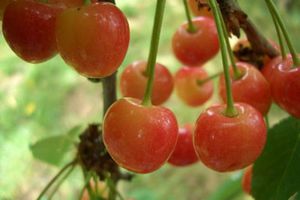The cherries are delicious, juicy and very healthy. For a long time, the cultivation of sweet cherry in the Moscow region remained a sweet dream of gardeners. But at the end of the last century, dreams came true: winter-hardy varieties were bred, which gardeners immediately fell in love with. But the cultivation of cherries in the Moscow region requires responsibility. This welcome guest from Asia Minor has her own tastes and preferences. She even loves to grow in a flower bed like a flower. This article will tell you how to please a sweet cherry sissy and get a good harvest.
Content
Cherry - the perfect combination of business with pleasure
The plant got its name from the toponym of the small Turkish city of Kerasunt, which in ancient times was famous for the abundance of cherries. The Romans noticed the bright, sweet berries and called them "Kerasunta", in Latin "cerasi". Sweet cherry quickly gained popularity among the people due to its fleshy and very tasty fruits. Of course, there was no talk of breeding and breeding varieties in those days, people used wild types of cherries.
In botany, the cherry is known as Prúnus ávium (bird cherry).
In addition to sweetness and excellent taste, cherries are useful and are an excellent remedy in the fight against many diseases.
Fruits contain a lot of carbohydrates, but they contain almost no proteins (1%) and fats (0.5%), and the calorie content is only 50 Kcal per 100 grams of berries. Sweet cherries are rich in carbohydrates, which are presented in the form of easily digestible fructose and glucose, so diabetics can afford a small amount of berries.
Cherry is rich in vitamins A, C, E, B1, B2, PP (nicotinic acid), pectins, iron and iodine, magnesium and phosphorus, potassium and calcium, iron, therefore it helps the human body to fight metabolic disorders, anemia, excess cholesterol and hypertension. Scientists note the complex effect of a wonderful berry on the body: sweet cherry has a beneficial effect on the functioning of the heart, intestines, liver, kidneys, endocrine and nervous systems. Even the common cold is treated with fresh fruits and jam.
The pigment substances contained in red and burgundy cherries have anti-inflammatory and antioxidant effects. It is worth noting that red berries can cause allergic reactions, so people prone to allergies are better off eating yellow varieties of cherries.
In the passion for cherries, as in everything, you should know when to stop. In order for it to bring only benefits, you need to eat no more than three hundred grams of berries per day.
Cherry varieties, zoned for the Moscow region
For a long time, the cultivation of sweet cherries remained an unattainable dream for gardeners in the Moscow region.But thanks to the long and painstaking work of breeders at the end of the last century, the first winter-hardy varieties appeared, intended specifically for cultivation in the Central region of Russia.
The variety decides the success of the business.
The State Register of Breeding Achievements recommended the following cherry varieties for cultivation in the Moscow Region:
Partially self-fertile:
- Iput. Medium-sized tree up to 4 meters high, with a spreading crown. Begins to bear fruit in the fourth year. Fruits are dark burgundy in color, large - 5-6 g, ripen at the end of June. The yield is high - up to 40 kg of berries from a tree. The variety is resistant to disease and pests.
- Astakhov's favorite. Medium sized tree, late ripening. The crown is oval, thin. The fruits are large, weighing about 8 g, with a high content of dry matter and ascorbic acid. The color of the skin and pulp is dark red, the subcutaneous points are practically absent. The variety is not susceptible to disease.
- Ovstuzhenka. Medium, early maturing tree. High winter hardiness - tolerates frosts down to –45 ° C. Fruits are medium-sized, juicy, tasty. The yield is high: 40-50 kg per tree. The oatmeal is resistant to disease.
- A gift from Ryazan. Tall tree of medium ripening. It has thick, strong shoots. The berries are large, weighing up to 7 g. The main color is yellow, the integumentary color is pink-red. The pulp is yellow, slightly crispy, sweet. The variety is frost-resistant, not afraid of diseases and pests.
- Jealous. Ripens at the end of July, begins to bear fruit in the sixth year after planting. Productivity is high. Fruits are medium in size, dark red, firm and juicy. The skin is almost black. Flowers are not afraid of recurrent frosts. The tree is slightly susceptible to fungal diseases.
- Tyutchevka. The tree is medium-sized, with a spreading crown in the shape of a ball. Fruiting begins in the fifth year. Berries are of medium late ripening, red, tasty, but prone to cracking in rainy summers.
Self-infertile:
- Bryanochka. A low tree, forms an unheated pyramidal crown. Differs in frost resistance not only of the whole tree, but also of flower buds. Fruits of a late ripening period, weighing about 5 g, are distinguished by a high content of ascorbic acid - up to 16%. The color of the skin and flesh is dark red. The first fruiting occurs in the fourth or fifth year after planting. Up to 35 kg of berries are harvested from one tree. Resistance to coccomycosis and moniliosis is average.
- Bryansk pink. A medium-sized tree with a medium dense crown. The fruits ripen in late July - early August. The berries are pink-yellow in color and slightly mottled, the flesh is yellow, dense, juicy and tasty. Productivity is average, up to 20 kg in normal years and up to 35–40 in productive years. The variety is winter-hardy, resistant to damage by coccomycosis, clasternosporiosis.
- Veda. A new variety of late ripening. Low-growing tree (up to 3 m), resistant to coccomycosis. Fruits are large - up to 7 g, heart-shaped, dark red, with delicate skin and pulp. Productivity up to 30-32 kg per tree.
- Gronkavaya. Begins fruiting in mid-June. Abundant fruiting - up to 35-40 kg. The berries are medium in size (4–4.5 g), red, tender and juicy. Winter hardy variety with good disease and pest resistance.
- Lena. Late-ripening, cold-resistant variety with high immunity to a complex of diseases. Abundant fruiting. The berries are large, 6–8 g, red-black. The pulp is tender and juicy, with a pleasant sourness. Distinctive features of the variety: the absence of stipules and the shape of the leaf curved "boat".
- Odrinka. The tree is medium in size, does not form a dense crown. The yield per tree is 32–37 kg. The fruits are large - weighing about 6 g, dark red, with tender and dense pulp, ripen at the end of July. The variety is characterized by winter hardiness and immunity to diseases and pests.
- In memory of Astakhov. Medium late grade.The fruit is dark in color, heart-shaped, juicy and tasty. They are characterized by a high content of vitamin C and sugars. The tree is frost-resistant, slightly damaged by pests and diseases.
- Raditsa. Weak (up to 3 m), early maturing tree. Berries of medium size, oval, red, weighing up to 4.5 g. The variety is winter-hardy and resistant to coccomycosis.
- Rechitsa. A mid-season variety, disease and frost resistant. Not susceptible to disease. The yield per tree is 30–35 kg. Berries are medium in size, tasty, tender.
- Sinyavskaya. High-yielding cherries - up to 45 kg per tree. Fruits are dark red, medium-early ripening, very tasty. Average fruit weight - 6 g. The variety is winter-hardy, not afraid of diseases and pests.
- Teremoshka. A low-growing, mid-season variety with a stable annual yield. Fruits are dark up to 5 g, the flesh is red, sweet, contains a lot of sugars and vitamin C. The yield is within 20-25 kg per tree.
- Fatezh. The tree is not tall, of medium density. Berries with red skin and pink tender pulp, ripen in the first or second decade of July, are distinguished by a high content of ascorbic acid (up to 30%). The yield is high - up to 50 kg per tree. The variety is resistant to fungal diseases.
- Chermashnaya. A very early variety, indispensable for fresh consumption. The fruits are yellow, with a sweet and sour taste, the stone is easily separated. The yield per tree is within 27–32 kg. It tolerates frost and is not afraid of pests and diseases.
Photo gallery: popular varieties of cherries for growing in the Moscow region
- The heart-shaped, bright red fruits of the Bryanochka cherry are distinguished by a high content of ascorbic acid
- Pink-yellow berries of Bryanskaya rose cherry contain a large amount of vitamin C
- The dark red fruit of the Veda cherry has a high sugar content
- Red, heart-shaped berries of the Gronkavaya cherry show a high content of ascorbic acid
- The large, red-black fruits of the Iput cherry are high in dietary fiber
- The dark red, large cherry berries Lyubimitsa Astakhova demonstrate a high dry matter content
- Oval, black-red cherry fruits Ovstuzhenka strengthens the vascular system
- Wide-rounded berries of the Revna cherry are distinguished by a high fiber content
- Large, dark red fruits of the Tyutchevka cherry are useful for strengthening the heart muscle
- The red-yellow fruits of the Fatezh cherry are distinguished by a high content of ascorbic acid
Cherries Valery Chkalov, Rodina, Orlovskaya pink, Poetry have also proven themselves well. These varieties are zoned in the Central Chernozem region, but they feel quite well in the Moscow region. Winters near Moscow, as the experience of gardeners shows, these cherries endure firmly.
In addition to the usual types of cherries, columnar ones that do not form side branches appeared on sale:
- Little Sylvia. Intensive type. May bloom in the first year after planting. It grows in height only up to 2 meters, the diameter of the crown is half a meter, therefore, it does not require thinning and shaping measures. The fruits are very large: up to 15 g, bright red, juicy and tasty. Winter hardiness and disease resistance are high. Requires top dressing: in the spring - nitrogen, in the summer - complex, in the fall nitrogen is excluded, leaving potash.
- Helena. Above Little Sylvia (up to 3 m in height), crown width about 1 m. Fast-growing, fruitful variety. It is immune to disease and frost resistant.
Video: cherries in the Moscow region
Planting cherries in the suburbs
Saplings should be purchased in special nurseries or specialized stores, giving preference to healthy, sturdy plants with a closed root system.
The seedling should have healthy, not rotten and dry roots (if they are open, check for growths, knots). The presence of a main stem or a conductor is mandatory, and it must be one, and not forked. Otherwise, the tree may break over time.
Winter-hardy varieties are demanding on planting conditions.Sweet cherry will be uncomfortable in lowlands, in open places blown by the winds, on poor soils with a close location of groundwater. To make the trees feel most comfortable, they are recommended to be planted on the south side of buildings, fences, in places that are well lit, protected from drafts and cold air stagnation.
Cherry trees love aerated, light, fertile soil that is rich in humus and earthworms. The best option is sandy loam or loam with a drainable bottom layer. Groundwater should lie no closer than 4–5 m to the surface. Tall varieties are planted according to the 6 by 5 m scheme; for varieties with compact crowns, an arrangement of 5 meters in a row from a row and 3-4 m in a row is permissible.
In regions with a short warm period and an abundance of rain, cherries are planted in two ways: in a pit and in a flower bed.
Landing in a pit:
- A pit is prepared with a diameter of 70 cm and a depth of 60–70 cm.
- 2 buckets of rotted manure and half a kilogram of wood ash are added to the ground extracted from the pit. To reduce the acidity of the soil, add 500-600 g of lime. At the bottom of the pit, you can add superphosphate and potassium sulfate (3 matchboxes each) and dig a little.
- A third of the earth, mixed with organic fertilizers, is poured into a mound on the bottom and a seedling is set. The hole is covered with the remaining soil mixture, lightly tamped and watered with two buckets of warm water. When the soil subsides, it is poured so as not to close the root collar.
- To protect against gusts of wind, the plant is tied to a peg, which is driven into the ground, stepping back 30 cm from the stem of the tree.
- After about two weeks, the seedling is watered, combining watering with fertilizing with nitrogen fertilizer: 30 g of urea per bucket of water.
Original, time consuming, but in many respects the method of planting cherries in a flower bed is justified. A flower bed means a bulk rounded elevation, in the center of which a tree is placed. The diameter of such an embankment is 2–2.5 m, the height is 60–70 cm.
It is prepared like this:
- They do not dig the soil under the flower bed. If it is heavy, with a high clay content, then a 10 cm thick drainage layer is introduced into the outlined circle - a mixture of coarse sand and fine gravel in equal proportions. If the soil is sandy, a mixture of peat and clay is used to retain moisture. 500-700 g of ash are poured over the drainage.
- The second layer, up to 30 cm thick, consists of rotted manure or compost. For each square meter, add 2 matchboxes of superphosphate and a box of potassium sulfate.
- The third, top layer consists of fertile soil, which is taken in the garden between the trees.
- After planting the plant, a 1 m diameter irrigation hole is made around it and watered with clean water so that the entire embankment is saturated.
- To strengthen the flower bed and enrich the roots of the tree with nitrogen around the seedling, it is recommended to sow a mixture of herbs (clover, bluegrass), which are mowed twice a month and left in the flower bed.
- When the herbs are sown, the surface is mulched with compost, retreating 10 cm from the trunk.
The advantages of landing on an artificial elevation:
- The roots are provided with the most favorable conditions for development; they are located in a heated, aerated and fertile soil.
- Stimulating root growth leads to an improvement in the condition of the entire tree, which has a beneficial effect on its yield and resistance to winter cold.
- Water does not stagnate at the base of the tree, which protects the bole from prying, and the berries from cracking.
The disadvantage of this method is the rapid drying of the soil and the need for more frequent and abundant watering. Therefore, where irrigation is often impossible, cherries are planted in the usual way.
Video: planting cherries - practical advice
Cherry care
In order for a tree to grow successfully, develop and have every chance of giving a bountiful harvest, it must be looked after.
Watering
Cherry reacts to drying out of the soil by reducing the yield, to waterlogging - by cracking and rotting berries. Therefore, it is necessary to find a "golden mean", which in each garden and in different years will be slightly different due to the different composition of the soil, the frequency of rain and the capabilities of the gardener. You still have to water the plants three or four times a season. Watering twice is combined with the introduction of complex fertilizers.
Pruning
There are three types of pruning of stone fruit trees:
- Formative. Its purpose is to create a beautiful, regular shape, strong crown. Proper formative pruning promotes rich harvests and increases disease resistance.
- Sanitary. Removal of dry, broken, infected branches. They are certainly burned after pruning.
- Unscheduled. Removing branches that cannot support the weight of the fruit when the crop is abundant. Such pruning is done very carefully and only if absolutely necessary.
For pruning, you must have a sharp, clean knife and means of protecting the cut from infections (garden pitch, special mastics).
Pruning in the first year after planting is not recommended, since the seedling needs to get stronger and adapt to not very favorable conditions in the Moscow region.
For pruning in the second year in early spring, the following scheme is recommended:
- Branches in tiers are left in an amount of 4-5, up to 50-60 cm long, placing them around the trunk at an equal distance from each other.
- The main stem is shortened 15–20 cm above the end of the highest lateral branch.
In the third year, pruning is more difficult:
- In the lower tier, the smallest branch is selected and oriented along it, cutting off the rest.
- The branches of the second tier are made 10 cm shorter than the first.
- The main stem should rise 50 cm above the branches of the second tier and have 6–7 buds for the subsequent formation of branches of the third tier;
- At the same time, remove all "incorrect" growing shoots (inside the crown, vertically).
In the fourth year, the formative pruning comes to an end:
- The main trunk is limited in growth by cutting to the desired height.
- Lateral shoots of the second and third tier are shortened to 80 cm, the first to 50 cm.
- They remove crowns growing inward and crossed shoots (leaving one of them), weak and underdeveloped.
The tree as a whole is formed, and since the sweet cherry is not prone to thickening the crown, in future years it will need minimal pruning, maintaining a height of about 3-4 m and the length of the branches - 4-4.5 m.
When pruning, one should remember about the property of cherries to form most of the crop on two-three-year shoots and at the base of annuals. Therefore, you need to be very careful with the removal of annual shoots.
Some gardeners advise not to cut, but to form the crown by bending young powerful shoots with a ring or half ring, followed by fixation with wire or twine.
Video: how to form cherries correctly
Graft
Cherry grafting may be necessary for several reasons:
- increasing winter hardiness, disease resistance;
- obtaining several varieties on one tree;
- rejuvenation of the "old" tree with varietal scion.
Types of vaccinations:
- with one "eye", kidney - budding;
- by cutting - copulation, grafting for the bark, in the lateral incision, in the split;
- whole plants - ablation.
The simplest and most successful methods: copulation, by the bark, into splitting. Sweet cherries are grafted onto winter-hardy varieties of cherries (Shubinka, Pika, Vladimirovka), as well as plums and even old cherries, which have lost their productivity, but have acclimatized and are not afraid of frost. The grafting is carried out in the spring, when the air temperature rises above five degrees Celsius and the juices begin to move in the plants. But some gardeners believe that grafting is better before the juices start moving, a week or two.
Grafts (cuttings that will be implanted into the trunk of another plant) are best prepared in the fall and stored in a cellar, in wet sand.The best material for him is lignified shoots up to 20 cm long and up to a centimeter thick. In spring, the scion can be “awakened” by keeping it in melt water for five to six hours.
The procedure for performing improved copulation of cherries:
- Take a scion and stock of the same thickness, preferably one-two-year-old shoots. With a knife, make oblique cuts on the cuttings so that their angle coincides when combined. Cut length about 3-4 cm.
- In the center of the slices, make transverse cuts, "tongues", for better attachment of the cuttings.
- Press the scion and rootstock tightly so that the "tongues" stick together.
- Seal the vaccination site with tape or tape.
- Insulate the junction with a plastic bag for two weeks.
The method of grafting into cleavage is also simple:
- Prepare a place on the rootstock branch: an even cut, cleaned with a knife.
- In the center of the saw cut with a hatchet, make a split up to 10 cm. A pointed stalk of the scion should fit into the split.
- Using side cuts on the lower part of the scion, form a wedge, the length of which should coincide with the depth of the split.
- So that the split does not close, insert a screwdriver or a strong branch into it, remove the hatchet.
- Place the scion wedge in the rootstock split. If the stock is much wider, insert two cuttings.
- Remove an unnecessary branch or screwdriver from the split.
- Secure the top of the stock with tape or duct tape.
- Cover all the bark-free places with garden pitch.
Grafting plants is a complex but interesting business. Experienced gardeners grow five to six varieties of cherries on one trunk.
Since cherries grow more intensively than cherries, the grafted branches become thicker than the rootstock. In this case, furrowing is carried out - longitudinal cuts of the bark.
Video: grafting cherries
Protection from pests and diseases
Sweet cherries are ill due to improper care, insufficient nutrition. The most common diseases of sweet cherry are:
- Clasterosporium disease, or perforated spot. It appears as brown spots on leaves, shoots, flowers. The affected areas die off, fruits and leaves fall off. A 1% solution of copper sulfate, with which the tree is sprayed before bud break, will help to fight the scourge. After flowering, they are treated with Bordeaux liquid. The affected plant parts must be removed and burned.
- Moniliosis (gray rot, monilial burn). Signs: drying out of flowers and branches, fruit rot. A double treatment with Bordeaux liquid is carried out: at the end of flowering and after harvesting. Sanitary measures are of great importance: removal and destruction of diseased fruits, branches, foliage.
- Coccomycosis. First, it manifests itself as small reddish spots on the leaves. Can jeopardize crops and severely harm the health and hardiness of the entire plant. To prevent the disease, even before bud break, the tree is sprayed with a 1% solution of Bordeaux liquid, and then twice - in budding and after flowering - with Horus (3 g per 10 l of water).
The bred cherry varieties are resistant to many pests and diseases, but they are defenseless against birds. The birds cause significant damage to the crop. The only means of dealing with them are nets that are thrown over the crowns and various devices to scare away birds. Long strips of rustling polyethylene hanging from the branches also help.
Table: cherry pests and control measures
| Pest | Remedy | When we apply |
| Black cherry and apple-plantain aphid | Confidor | the first time before the kidneys wake up, the second after 2 weeks |
| A solution of 200 g of tobacco dust in 10 liters of water with the addition of soap for better adhesion | during the period of greatest spread | |
| Cherry fly | Yellow sticky traps made of plastic or plywood | from the beginning of flowering |
| according to instructions | |
| Cherry pipe wrench | A solution of 1.5 g Aktara per 10 l of water | first treatment immediately after flowering |
| the second after 2 weeks | |
| Winter moths |
| before flowering |
| early spring before bud break |
An excellent measure for pest control is spring and autumn whitewashing with lime with the addition of clay, which has a positive effect on the winter hardiness of trees. Preventive spraying with urea is also used in early spring, before flowering: 300 g of fertilizer is dissolved in a bucket of water.
What better way for a gardener than to harvest a bountiful harvest of selected sweet berries? And if they are also suitable for winter preparations, this is the ultimate dream. Thanks to the efforts of breeders to grow cherries in the Central region of Russia, it has become a reality, for which they are constantly thanked by lovers of fruit crops. Taking care of cherries in the Moscow region, you will have to work hard, but any fatigue will be removed at once when you receive a wonderful generous harvest.
